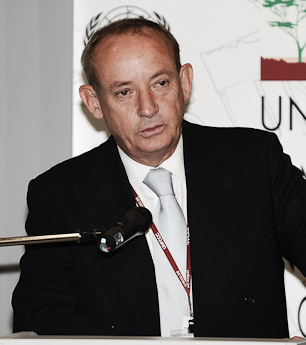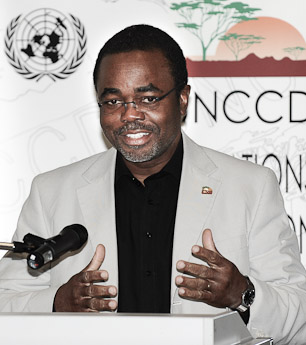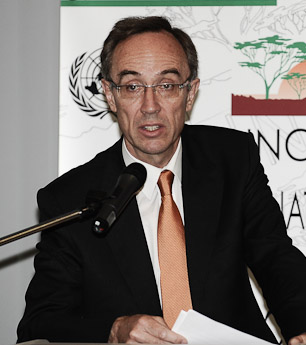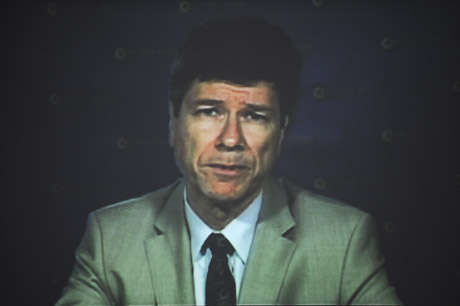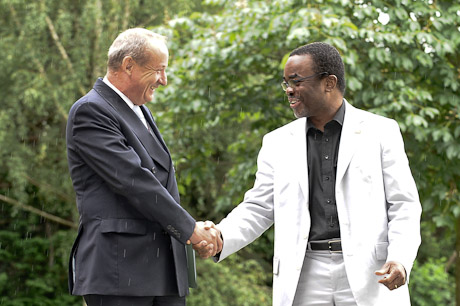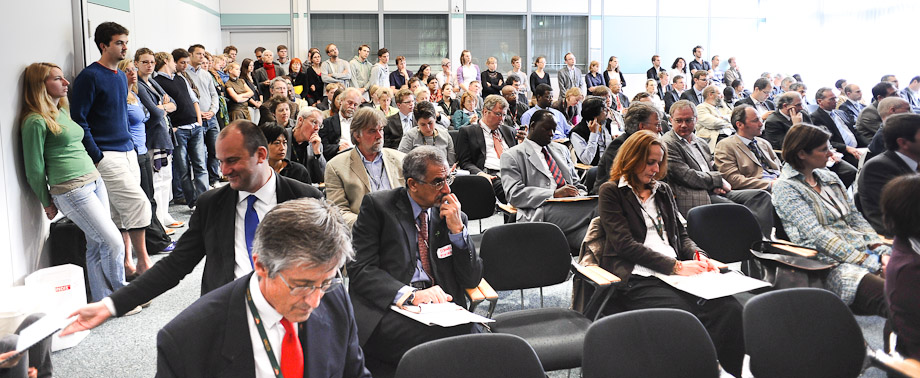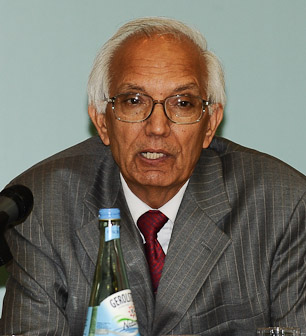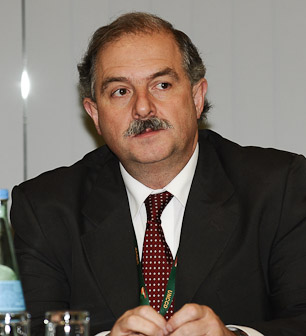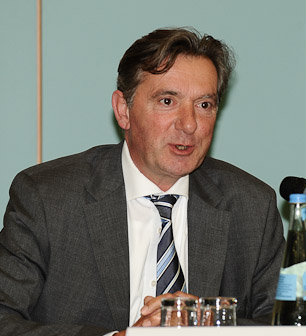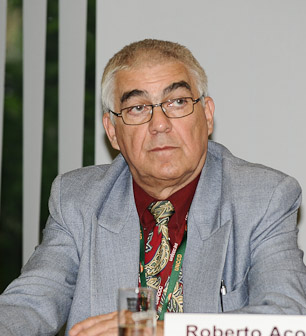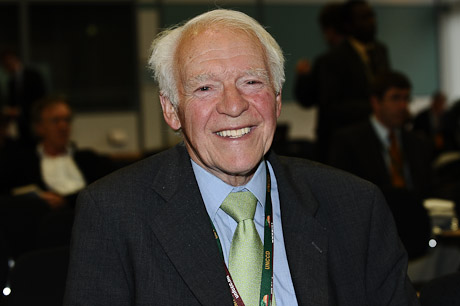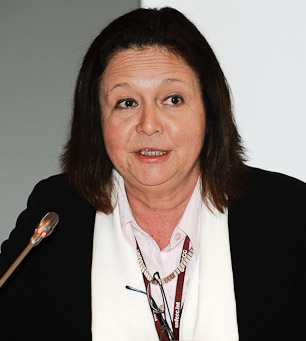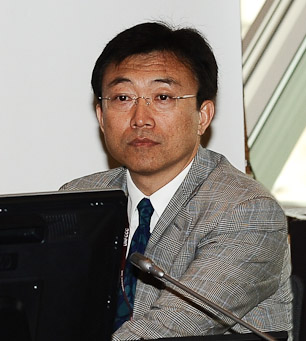 |
A Special Report on Selected Side Events at the 1-12 June 2009 Bonn, Germany |
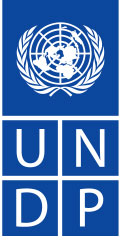 |
| Daily Web Coverage and Reports | ||||||||||||||||||||||||
| 1 June | 2 June | 3 June | 4 June | 5 June | 6 June | 8 June | 9 June | 10 June | 11 June | 12 June | ||||||||||||||
| HTML | ||||||||||||||||||||||||
Events on Saturday, 6 June 2009
Special Report on UNCCD Land Day On Saturday 6 June, the UN Convention to Combat Desertification (UNCCD) Secretariat hosted “Land Day” at the Gustav-Stresemann-Institut, Bonn, Germany. The event, attended by 170 participants, aimed to help climate change negotiators and other stakeholders attending the concurrent Bonn climate change talks consider in detail the linkages between climate change and desertification, land degradation and drought (DLDD). The event was opened by Luc Gnacadja, UNCCD Executive Secretary, Yvo de Boer, UNFCCC Executive Secretary, and Adolf Kloke-Lesch, Federal Ministry for Economic Cooperation and Development (BMZ) Director-General. Jeffrey Sachs, Earth Institute Director, Columbia University, offered a pre-recorded keynote address. Participants then attended three panels, entitled: "How does sustainable land management support climate change adaptation?"; "What options can soil carbon sequestration offer for mitigating and adapting to climate change?"; and "Sustainable land management in climate change policy frameworks: what is the way forward?" This special edition of ENBOTS highlights a selection of the day’s events. Opening Ceremony and Keynote Address Luc Gnacadja, UNCCD Executive Secretary, stressed that land has an unparalleled capacity to sequester carbon, but its potential to mitigate climate change is presently untapped. Emphasizing that numerous opportunities exist to include land within a post-2012 climate regime, he said the Clean Development Mechanism (CDM) and carbon markets must be changed and made accessible to farmers and land managers. Gnacadja argued that soil restoration and soil carbon sequestration offer “win-win-win” opportunities for climate change, biodiversity and desertification. Noting that “poor soils lead to poor people,” he further suggested that inclusion of desertification, land degradation and drought in a future climate regime has the potential to bring more equity and justice to developing countries. Yvo de Boer, UNFCCC Executive Secretary, discussed the linkages between the agriculture and forest sectors and climate change mitigation and adaptation. He highlighted that 10-12% of total annual greenhouse gas (GHG) emissions come from agricultural practices, and that deforestation accounted for 20% of GHG emissions in the 1990s. Underscoring that some mitigation options can be realized at “low or even negative costs,” de Boer highlighted a number of possibilities in these sectors, including: reducing emissions from deforestation and degradation in developing countries (REDD); improved crop and grazing management; and restoration of organic soils. He added that mitigation options, such as agroforestry, support adaptation and promote biodiversity. Adolf Kloke-Lesch, Director-General, German Federal Ministry for Economic Cooperation and Development (BMZ), said climate change threatens to destroy the efforts and achievements of sustainable development. Noting that land degradation was previously considered a collection of local problems, he argued that today it is understood as a global problem that must be part of the global environmental agenda. Kloke-Lesch stated that sustainable land management offers a cost-effective solution to mitigating climate change and that natural infrastructures, such as forests and soils, must be part of this solution. He stressed that sustainable land management must become an integral part of climate protection strategies in a new “Green Deal” forged at the 2009 climate change talks in Copenhagen. In a pre-recorded message, Jeffrey Sachs, Earth Institute, Columbia University, underscored the importance of integrating the urgent agendas of drylands and global climate change. He said drylands are amongst the most vulnerable areas to climate change, and that impacts in dryland countries are compounded because these countries are also experiencing demographic pressures and have large populations living in poverty. Sachs explained that the combination of these factors is “at the root” of some of the greatest security challenges on the planet, noting these issues must be addressed to lessen security risks not only for the people in these regions but for the entire world. He called for several responses, including: better science on the effects of climate change in dryland regions; increased understanding of human systems, such as the impacts of climate change on herders’ livestock assets; and increased understanding of intervention measures that are needed for adaptation and climate change preparedness. Sachs emphasized the need for a holistic approach in addressing these issues, highlighting the potential for ecosystem-based adaption in this regard.
What Options Can Soil Carbon Sequestration Offer for Mitigating and Adapting to Climate Change? Paul Vlek, Center for Development Research (ZEF), Germany, presented research measuring the Normalized Difference Vegetation Index across Africa over the last 25 years. He noted that after accounting for cyclical rainfall patterns, the data show that primary productivity is declining in 10% of agricultural areas, which is most logically explained by land degradation. Daniёlle de Man, International Federation of Agricultural Producers, said the agricultural sector has the capacity to mitigate 5.5-6 Gt CO2 annually by 2030, of which 89% would result from soil carbon sequestration, 70% of which would occur in developing countries. She lamented that farmers are not yet recognized as partners in climate change mitigation, noting that they already undertake soil carbon sequestration activities, including cropland management, grazing land management and restoration of cultivated organic land. de Man highlighted the American Farmer’s Union Carbon Credit Program, in which farmers commit to undertaking certain land management practices, which the Union aggregates and sells as carbon credits on their behalf on the Chicago Climate Exchange. Rattan Lal, Ohio State University, stressed the relevance of “soil amendment” to climate change mitigation and adaptation, explaining that it involves the application of organic and inorganic materials to soils to improve soil quality, increase natural productivity and enhance the environment. He said soil carbon should be used as an indicator of climate change. Lal emphasized that there is “no silver bullet” solution to sequestering carbon, and that a range of context-specific actions are most appropriate. He noted that hot and dry climates typically have slow rates of carbon sequestration, and concluded by highlighting ten principles of soil management, including that “marginal soils cultivated with marginal inputs produce marginal yield and support marginal livelihoods.” Daniel Martino, Carbosur, Uruguay, highlighted challenges related to ensuring measurable, reportable and verifiable (MRV) actions. He stated that although uncertainties related to agriculture exist, they are not significantly different from those in other sectors and do not warrant excluding agriculture from a future climate change mitigation system. Highlighting where improved measurements are required and where useful methodologies exist, he said measurement is the biggest challenge related to MRV. He suggested that remote sensing is a useful tool for verification but is not yet appropriate for measurement. Peter Holmgren, UN Food and Agriculture Organization (FAO), stressed that: land management can contribute greatly to global GHG emissions but sustainable land management is a “win-win” solution; and while changes in land management can sequester carbon, “soft issues,” such as land tenure and governance barriers, severely limit this possibility. On adaptation, he emphasized that mitigation activities, such as crop diversification and agroforestry, can rebuild resilience to climate change impacts by decreasing the number of “problem years.” Barney Dickson, UN Environment Programme – World Conservation Monitoring Centre, said the current UNFCCC regime deals inadequately with Land Use, Land-Use Change and Forestry. He elaborated that the UNFCCC currently makes no reference to drylands but noted that the current draft negotiating text of the Ad Hoc Working Group on Long-term Cooperative Action includes reference to agriculture, soil carbon, drylands and land use. He cited lack of MRV systems and weak institutions as key challenges to including drylands in a future climate regime. Participants discussed, inter alia: uncertainties related to biochar; the role of remote sensing in MRV; tradeoffs associated with the biofuel sector; and the role of forest degradation as part of land degradation.
Sustainable Land Management in Climate Change Policy Frameworks: What is the Way Forward? Christian Mersmann, Global Mechanism, stressed that drylands should not be considered separately from non-drylands because many countries have both. On financing mitigation actions in developing countries, he emphasized that while sustainable land management is a major mitigation source, alone it “may not be enough” to convince finance ministers to prioritize these activities. He said finance proposals must be “packaged” so as to integrate them with development objectives. Johan Kuylenstierna, UN Water, noted that although land and water are intrinsically linked, institutional collaboration between the sectors is limited. He highlighted the significant impacts of trade on land and water and stressed the importance of understanding the drivers and interactions among water, food, energy and economic security. Roberto Acosta, UNFCCC Secretariat, discussed options for including land management practices in a future climate regime. In this regard, he suggested that land management practices, such as soil restoration, could be included under nationally appropriate mitigation actions (NAMAs). Acosta stressed that in order to ensure that non-Annex I countries with drylands benefit from the climate negotiation outcomes, they must be ready to implement any relevant outcomes that emerge. Stating that 75% of the world’s poor live in rural areas and are mostly involved in farming, Mark Cackler, World Bank, noted that the poverty reduction potential of agriculture is between two and four times greater than non-agricultural poverty-reduction options. Cackler argued that good rural agricultural development has many mitigation and adaptation benefits. Noting the particularly high proportion of carbon stored in soils in Africa, he said the continent’s farmers should be able to benefit from the carbon they sequester through land management practices, as should all farmers worldwide. Participants discussed, inter alia, reasons for excluding soils and forest management from the Kyoto Protocol, and the role of REDD in shifting the dynamics of current climate change negotiations.
In a closing session, the Land Day panel moderators offered concluding remarks. Amb. Bo Kjellén, Sweden, underscored that both the climate negotiations and the UNCCD’s 10-year strategic plan would benefit from a common goal. On soil carbon sequestration, Paul Vlek, ZEF, summarized that agriculture should be fully integrated in future UNFCCC strategies and that farmers must be central in this regard. On financing, he added that farmers need immediate returns for their actions. Simon Anderson, IIED, underscored that climate change is a multiplier of other stressors. Luc Gnacadja, UNCCD Executive Secretary, closed the event by highlighting that: adaptation financing is a sound way to secure everybody’s future; synergies will not occur by accident but must be promoted and monitored; carbon sequestration is measurable, cost-effective and provides multiple co-benefits; agriculture must be integrated into a future climate regime; and a comprehensive study on the economics of sustainable land management should be conducted.
|
TNA Handbook: Facilitating Innovation to Move Towards a Low-Carbon Future
Presented by the United Nations Development Programme (UNDP)
This event brought together experts from the UNDP, other international organizations, governments and the private sector to discuss a draft handbook on technology needs assessments (TNAs).
Veerle Vandeweerd, UNDP, introduced the panelists and said the TNA handbook was prepared with input from a large number of experts and covers both mitigation and adaptation technologies. Noting that climate change is a development issue, she stressed interlinkages between poverty reduction, sustainable development and efforts to build a low-carbon society.
Bruce Wilson, Australia, noted that TNAs have a foundational role to play in current and future climate policies at national and international levels, and stressed that the new handbook is a marked improvement over a previous version.
Vladimir Hecl, UNFCCC Secretariat, summarized patterns in the 69 country TNA reports received by December 2008. He said the most commonly identified technology needs for mitigation relate to: renewable energy; energy efficiency; waste management; and low-emission vehicles. He continued that the most needed adaptation technologies pertain to: crop management; efficient water use; irrigation systems; and early warning systems for forest fires. Stressing the need to implement TNA results, he pointed out that a guidebook on preparing technology transfer projects for financing has been developed to assist countries in this regard.
Minoru Takada, UNDP, gave a detailed description of the TNA handbook, noting that the complete version will be released in Copenhagen in December 2009. He stressed the importance of responding to country development priorities and feeding TNAs into NAMAs and NAPAs.
Takada said the handbook: includes a step-by-step guide for prioritizing sectors and technologies; covers short-term and long-term technology options; extends technology implementation analysis to sectoral and national levels; and contains new software for multi-criteria decision analysis.
He further elaborated on key next steps for countries, including: establishing national TNA teams; engaging stakeholders; making strategic choices for priority sectors and technologies; and accelerating technology development, deployment and diffusion.
Peter Storey, Pan Pet Limited, US, offered perspectives from the private sector, which he said has a vital role to play in financing and implementing technology development and technology transfer.
Zhihong Zhang, GEF, emphasized that his organization requires rigorous, “actionable and implementable” TNAs, and that the ultimate goal is to go beyond identifying technology needs to developing national technology action plans that prioritize mitigation and adaptation. Noting that countries sometimes fail to develop proposals for technology transfer even when funding exists, he said stakeholders who work on TNAs must work with those who develop projects on the ground.
Kaveh Zahedi, UNEP, said the evolution of TNAs must be a dynamic process involving regular feedback to ensure constant improvement of the handbook. He said TNAs and technology transfer are important steps in shaping a new, green economy for the 21st century.
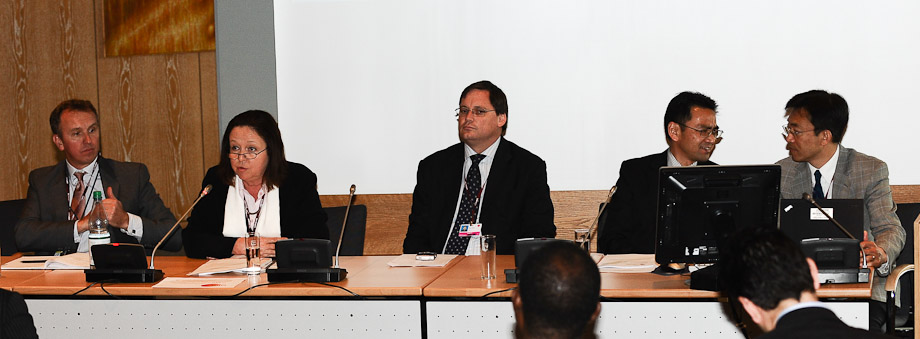 |
| L-R: Peter Storey, Pan Pet Limited; Veerle Vandeweerd, UNDP; Bruce Wilson, Australia; Minoru Takada, UNDP; and Zhihong Zhang, GEF |
|
|
European Commission Communication: Toward a Comprehensive Climate Change Agreement in Copenhagen
Presented by the European Community
Martin Weiss, European Commission (EC), presented the EU vision of a global response to climate change, noting that the goal of limiting temperature rise to 2°C requires reducing global emissions by 50% and developed-country emissions by 80-95% by 2050.
He identified key issues for COP 15, including: determining comparable targets; developing nationally appropriate mitigation actions (NAMAs); negotiating funding mechanisms for mitigation and adaptation in developing countries; and establishing international carbon markets. He said policy costs depend on how comparable targets are determined, for example by ability to pay, emission-reduction potential, population growth and/or domestic early action.
On NAMAs, he said the EU supports: developing country “ambitions” of 15-30% emission reductions below a business-as-usual scenario; improved MRV to assess environmental effectiveness; and regular implementation reviews. Noting that under a new agreement the EU would prefer to differentiate countries according to types of action rather than categories, he suggested that NAMAs be determined on an individual country basis. He also called for establishing a facilitative mechanism for mitigation support to assess levels of ambition, and a NAMA registry that lists domestic actions and achieved reductions.
On technology, Weiss suggested: building on existing international networks; reducing market barriers; and quadrupling research, development and deployment expenditures by 2020.
On finance, he elaborated on three mutually supportive options: the use of carbon markets; public grants from developed countries; and loan programmes for developing countries. He speculated that half of mitigation efforts are likely to be low-cost, and that one-third of these could be financed by carbon markets. He added that adaptation is expected to cost €23-54 billion annually by 2030, and described two alternative proposals for adaptation finance mechanisms.
On international carbon markets, Weiss said the EU supports: establishing an OECD-wide carbon market by 2015, which would be extended to include “advanced developing economies” by 2020; and phasing out the CDM in favor of a sectoral carbon market crediting mechanism. He said offsetting alone cannot solve the climate problem and stressed the need for domestic actions by developing countries that are unrelated to carbon markets.
Two discussants from the EC then responded to questions and comments from participants. The first discussant clarified that the EU has not made final decisions on international financial mechanisms but supports initial reliance on public funding followed by incremental reliance on carbon market revenues. He stressed the importance of determining accounting rules before setting emission targets, and said the focus should be on creating the right incentives for developing country actions.
The second discussant said that while the EU takes adaptation seriously, unlike in mitigation, it has not developed elaborate goals in a quantitative manner. On financing adaptation, she noted that the EU advocates the use of existing channels of funding while parties consider a Mexican proposal for a global fund on adaptation with country contributions.
|
|
| Daily Web Coverage and Reports | ||||||||||||||||||||||||
| 1 June | 2 June | 3 June | 4 June | 5 June | 6 June | 8 June | 9 June | 10 June | 11 June | 12 June | ||||||||||||||
| HTML | ||||||||||||||||||||||||
Digimarc and the Digimarc logo are registered trademarks of Digimarc Corporation. The "Digimarc Digital Watermarking" Web Button is a trademark of Digimarc Corporation, used with permission.
Please e-mail the Digital Editor should you have any questions regarding the content of this page.
| Back to IISD RS "Linkages" home | Visit IISDnet | Send e-mail to ENB |
© 2009, IISD. All rights reserved.



